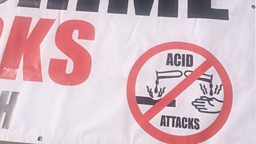Why are acid attacks on the rise?
In the BBC Radio 4 documentary Vitriolic, journalist Ayshea Buksh meets victims of acid attacks who have been scarred for life and had to undergo major surgery in their long recovery. Here she looks at the complex picture behind the rise in attacks.

For the past few years there have been – what seemed to be – isolated incidents of acid attacks. The attacks had seemed random and were often targeted against people who had some sort of link to their attacker. But now that appears to have changed.

This summer there was a dramatic spike in incidents. And, in one night, six people – all within a few miles of each other in east London – became victims.
What’s going on?
I discovered that, according to the charity Acid Survivors Trust International, the UK currently has the highest reported number of acid attacks in the world.
The National Police Chiefs Council’s lead on corrosive attacks, Rachael Kearton, says the number of incidents has in fact doubled in the last year. “London has the majority, but this is now a national problem from Northumberland to Cornwall,” she said. “The motivations are all different – hate crime, domestic violence, robbery. The acid is often used as an enabler for a crime.”
Speaking out
Globally the majority of acid attack victims are still female – the assaults often resulting from men exercising coercive control or exacting revenge. But here in the UK the increase in attacks involve men against men. One of those victims from that night in east London tells me he is now scared to go out at night, but not scared to speak out.
This is now a national problem from Northumberland to Cornwall.Rachel Kearton (Assistant Chief Constable)
Jabed Hussein was a moped delivery driver, delivering take away food to Londoners. A few weeks after his attack he organised a demonstration with drivers outside Parliament. He says the law needs to change around possession of acid and restricting those who buy it.
But it’s a hard one to control. Acid is the commonly used word for corrosive substances which can mean anything from household bleach to specially mixed sulphuric acid bought on the Internet.

I spoke to some of the other drivers who work in east London at their meeting point in Hackney. They work long hours on their mopeds and the acid attacks have really frightened them. They talk about the need to feel better protected out on the roads, and claim it’s “kids” that are threatening them and trying to steal their bikes.
It’s instant torture in a bottle.Simon Hardings (Criminologist )
So is it really just kids?
Criminologist Simon Hardings says acid attacks have been around for 200 years, since the Industrial Revolution. But, the casual way that it’s being used by urban street gangs is something new. It gives them power and control over victims, “permanent victimhood – it’s instant torture in a bottle”.
Beth Murray, who works at a gangs exit charity, interacts with children as young as 13. She tells me young people, operating in a different reality, are fascinated by acid. “People aren’t scared of knives or being stabbed any more. Acid is the new threat.” It’s easy to obtain and you can harm someone from a distance, squirting the liquid at them and then running away.

Janette Collins runs an incredible youth project called The Crib in Hackney – I worked with her on a Woman’s Hour series on knife crime last year. The latest thing she must educate young people about is acid. But she warns that if the media portray it as a trend, young people will follow. And Janette says it’s not just young people who are using it.
Samir Hussein was leaving the cinema in Crawley, West Sussex, when he had acid thrown at him by a man in his late 20s. Michael McPherson was convicted and imprisoned for eight years, which Samir feels was not enough. He says he has to spend his whole life dealing with what happened. He was badly burnt on his face and body, and must wear a facial mask for 23-hours a day to help heal his scars. But with the support of his family he is determined to stay positive.
There may be a heightened sense of fear around acid, but attacks are still rare. But, with the NPCC working with the Home Office, youth workers asking for more support and survivors speaking out and demanding change – there is hope.
-
![]()
Listen: Vitriolic
Journalist Ayshea Buksh looks at the complex picture behind the rise in acid attacks.
More features from Seriously...
-
![]()
Five slogans to live your life by
Could you really live by the words of a slogan? We test out five.
-
![]()
Ten words that prove you aren't posh
Just how common is your language? These words show if you are U or Non-U.
-
![]()
Are you beach pod ready?
Five podcasts to take on your travels.
-
![]()
Why Ian McMillan loves being early
The early-bird poet and broadcaster tries to arrive early to everything.
-
![]()
Fake wine – honestly, it’s a thing
Here’s what Radio 4 has uncorked about the fake wine industry.
-
![]()
Five Steps to the Creative World of Cosplay
An insight into the world of fictional characters brought to life by fans.
-
![]()
The death and rebirth of Zora Neale Hurston
Once forgotten, she is now revered by everyone from Alice Walker to Solange Knowles
-
![]()
Seven of literature's lustiest lovers
From Tom Jones to Adrian Mole, have a look at lust in literature.
-
![]()
Meet the cyborgs
Five people who have modified their bodies with technology.
-
![]()
Miles Jupp asks if a woman invented James Bond...
Phyllis Bottome is little known today, but did she inspire Ian Fleming?
-
![]()
Five ways to burst your social media bubble
DJ Bobby Friction on how to escape the online echo chamber.
-
![]()
The Story of The Green Book, by Alvin Hall
A travel guide like no other for black motorists in the mid-20th Century.
-
![]()
Apathy in the UK
Phill Jupitusr on boredom.
-
![]()
What is a 'curvalicious' body?
Bridgitte Tetteh explores attitudes to female bodies in the black community.
-
![]()
Sitting for David Hockney
Art critic Martin Gayford learns what it's like to be painted by a master.
-
![]()
Why having a baby needn’t subdue your inner geek
Five tips from Isy Suttie.
-
![]()
Miles Davis on canvas
The legendary trumpeter's second life as a painter.
-
![]()
Ey Up! It's The Sex Pistols
The Sex Pistols visited Yorkshire twice, but what impression did they leave?
-
![]()
William Shakespeare's America
Robert McCrum traces the Bard's influence in the USA.
Podcast
-
![]()
Seriously..
A rich selection of documentaries aimed at relentlessly curious minds. Download Seriously... via your favorite podcast provider.





















